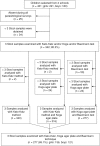Diagnosis of soil-transmitted helminths in the era of preventive chemotherapy: effect of multiple stool sampling and use of different diagnostic techniques
- PMID: 18982057
- PMCID: PMC2570799
- DOI: 10.1371/journal.pntd.0000331
Diagnosis of soil-transmitted helminths in the era of preventive chemotherapy: effect of multiple stool sampling and use of different diagnostic techniques
Abstract
Background: Soil-transmitted helminth infections are common throughout the tropics and subtropics and they disproportionately affect the poorest of the poor. In view of a growing global commitment to control soil-transmitted helminthiasis, there is a need to elucidate the effect of repeated stool sampling and the use of different diagnostic methods in areas targeted for preventive chemotherapy that are characterized by low-infection intensities. In this study, we focused on schoolchildren on Unguja Island, Zanzibar, an area where anthelminthic drugs have been repeatedly administered over the past decade.
Methodology/principal findings: Three serial stool samples from each of 342 schoolchildren were examined using the Kato-Katz (K-K), Koga agar plate (KAP), and Baermann (BM) techniques. These methods were used individually or in combination for the diagnosis of Ascaris lumbricoides (K-K), Trichuris trichiura (K-K), hookworm (K-K and KAP), and Strongyloides stercoralis (KAP and BM). The examination of multiple stool samples instead of a single one resulted in an increase of the observed prevalence; e.g., an increase of 161% for hookworm using the K-K method. The diagnostic sensitivity of single stool sampling ranged between 20.7% for BM to detect S. stercoralis and 84.2% for K-K to diagnose A. lumbricoides. Highest sensitivities were observed when different diagnostic approaches were combined. The observed prevalences for T. trichiura, hookworm, A. lumbricoides, and S. stercoralis were 47.9%, 22.5%, 16.5%, and 10.8% after examining 3 stool samples. These values are close to the 'true' prevalences predicted by a mathematical model.
Conclusion/significance: Rigorous epidemiologic surveillance of soil-transmitted helminthiasis in the era of preventive chemotherapy is facilitated by multiple stool sampling bolstered by different diagnostic techniques.
Conflict of interest statement
The authors have declared that no competing interests exist.
Figures


References
-
- Bethony J, Brooker S, Albonico M, Geiger SM, Loukas A, et al. Soil-transmitted helminth infections: ascariasis, trichuriasis, and hookworm. Lancet. 2006;367:1521–1532. - PubMed
-
- WHO. Schistosomiasis and soil-transmitted helminth infections – preliminary estimates of the number of children treated with albendazole or mebendazole. Geneva: World Health Organization; 2006. pp. 145–164. - PubMed
-
- Hotez PJ, Molyneux DH, Fenwick A, Kumaresan J, Ehrlich Sachs S, et al. Control of neglected tropical diseases. N Engl J Med. 2007;357:1018–1027. - PubMed
-
- Goodman D, Haji HJ, Bickle QD, Stoltzfus RJ, Tielsch JM, et al. A comparison of methods for detecting the eggs of Ascaris, Trichuris, and hookworm in infant stool, and the epidemiology of infection in Zanzibari infants. Am J Trop Med Hyg. 2007;76:725–731. - PubMed
Publication types
MeSH terms
Substances
LinkOut - more resources
Full Text Sources
Miscellaneous

